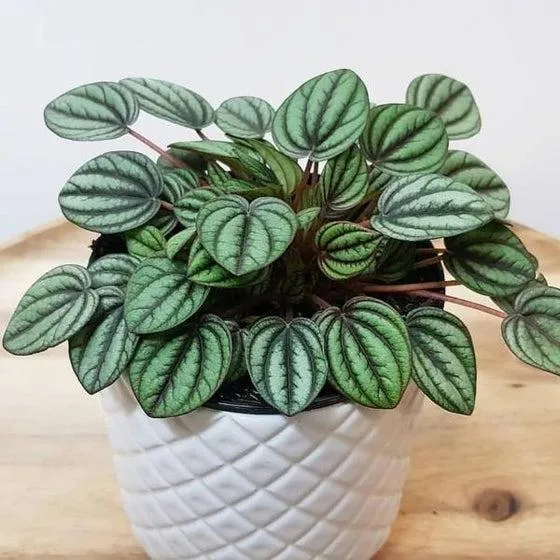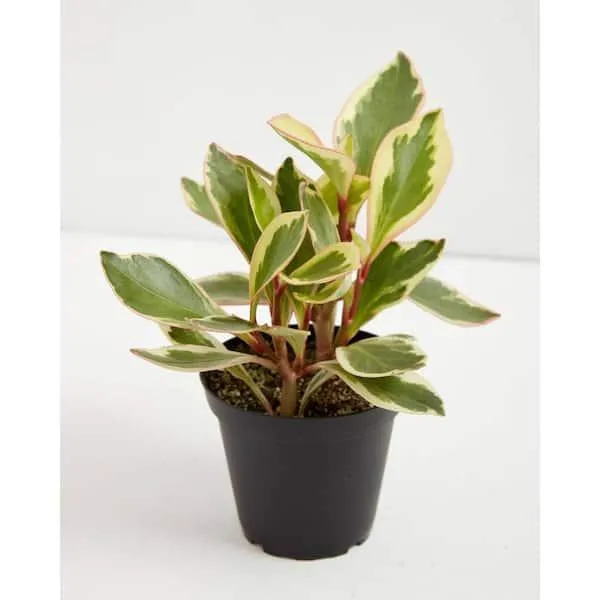Everything You Need to Know About Peperomia Peacock Plants
The peperomia peacock is one of the most attractive houseplants you can grow. With its dark green, variegated leaves splashed with shades of cream, pink, and orange, it’s sure to be the star of any indoor space. But beyond its good looks, there are many other reasons why this peperomia variety is such a popular choice. In this article, I’ll cover all the basics on caring for peperomia peacock plants so you can keep yours happy and healthy for years to come.
What Is a Peperomia Peacock?
- The peperomia peacock (Peperomia caperata ‘Ginny’) belongs to the peperomia genus, which contains over 1000 different species of succulent-like plants.
- It’s native to tropical regions like Central and South America. In the wild, peperomias can be found growing as epiphytes on tree trunks or rocks in moist environments.
- What makes the peperomia peacock stand out is its leaves, which are streaked and splashed with shades of pink, red, orange, and cream against a darker green backdrop. The colors are most vibrant on new growth.
From my experience growing peperomia peacocks, the variegated leaf patterns are always unique to each individual plant. No two peperomias will look exactly alike. The splotchy foliage gives them a tropically beautiful, almost exotic look that’s sure to brighten up any room.
Watering Peperomia Peacock Plants
When it comes to watering, peperomias are extremely forgiving as long as you don’t overdo it. The #1 killer of peperomia peacocks is usually too much water. Here are some tips:
- Let the soil dry out: Wait until the top 1-2 inches of soil are completely dry before watering again. This usually takes 1-2 weeks depending on conditions.
- Water thoroughly: When you do water, give the plant a good soak until water drains freely from the drainage holes. Don’t let it sit in water.
- Avoid soggy soil: Make sure your pot has drainage holes to prevent the roots from sitting in moisture for too long.
- Adjust based on lighting: Plants in lower light need watering less frequently than those in bright, sunny windows.
In general, underwatering a peperomia peacock is safer than overwatering. Feel the soil before watering and only do so when the plant is clearly thirsty.
Light Requirements for Peperomia Peacock
Peperomias thrive in medium to bright indirect light. Direct southern or western sun may cause leaf burn, so filter the light with a sheer curtain. Places to consider displaying your peperomia peacock include:

- Eastern windows – They receive morning sun but shade in the hot afternoon.
- West or east-facing windows partially blocked by trees – Dappled light is ideal.
- About 3-5 feet from a south-facing window – Too close and leaves may scorch.
- Any spot receiving 4-6 hours of indirect sunlight daily.
- Underneath a grow light if conditions are too dim.
Avoid very low-light areas like inside cabinets. The vibrant colors will fade if light levels are insufficient. Rotate your plant occasionally for even growth.
Fertilizing Peperomia Peacock Plants
When it comes to fertilizing peperomias, less is more. Their needs are quite low. During the growing season from spring to fall:
- Use a diluted liquid houseplant fertilizer once a month at half the recommended strength.
- Or, for a natural option, use compost tea brewed from worm castings or compost.
- Stop fertilizing in fall and winter when growth slows down.
- Only repot in new soil if the roots have filled the container.
Overfertilizing can cause burn marks, so go slowly. It’s OK if you occasionally skip a month. Use awell-draining potting mix like cactus/succulent soil.
Temperature and Humidity for Peperomia Peacock
When I lived in a drier climate, I noticed my peperomia peacocks really appreciated extra humidity. They prefer temperatures between 60-80°F and higher humidity levels around 50-60%. Here are some tips:
- Mist leaves daily with a spray bottle if indoor air is very dry.
- Group peperomias with other plants to raise the ambient humidity.
- Use a pebble tray or humidifier near the plant.
- Avoid sudden temperature drops from heating/AC vents.
- Protect from drafty spots near doors or windows.
Take your plant inside if outdoors overnight temperatures dip below 50°F. Overall peperomias are adaptable as long as their soil doesn’t freeze.

Pruning and Propagating Peperomia Peacock
Occasionally pruning leggy peperomia peacock stems can encourage a lush, full look. Simply cut 4-6 inches above soil level using clean shears. The cut stems often form new growth.
You can also easily propagate peperomias from stem or leaf cuttings. Remove a 4-inch stem section and place the cutting in water until roots emerge in 2-4 weeks. Then transplant into potting soil. Leaf cuttings can be laid on top of moist soil until roots take hold.
Before you know it, you’ll have an entire peperomia peacock family! Their fast growth rate makes them pretty to look at and easy to share.
Common Pests and Problems
Generally peperomias are not prone to major issues. However, here are a few potential problems and solutions I’ve encountered:
- Spider mites – Isolate and spray leaves weekly with water or neem oil to suffocate eggs and larvae.
- Mealybugs – Isolate, dip cotton balls in rubbing alcohol and wipe directly on bugs to kill on contact.
- Overwatering – Allow soil to dry completely and improve drainage if plant is yellowing.
- Underwatering – Water according to dry soil and light conditions discussed above.
- Low light – Move to a brighter spot and leaves may recover color over time.
With careful monitoring and fast action if you spot pests, peperomias are generally very resilient plants.

In conclusion, peperomia peacocks make wonderful low-maintenance houseplants to beautify your home. Follow the guidelines on watering, light, fertilizer and care discussed here and your peperomia peacock is sure to thrive for many years to come. Let me know if you have any other questions!
Peperomia peacock plant profile
| Characteristic | Details |
|---|---|
| Scientific Name | Peperomia caperata ‘Variegata’ |
| Growth Habit | Upright or trailing succulent |
| Foliage | Variegated green and white heart-shaped leaves with reddish veins |
| Light Requirements | Bright indirect light, tolerates low light |
| Water Requirements | Allow soil to dry between waterings, high humidity benefits plant |
| Temperature | 60-80°F, tolerant of cooler temperatures |
| Propagation | Stem cuttings in moist soil |
FAQ
-
What kind of plant is a peperomia peacock?
The peperomia peacock is a type of peperomia. Peperomias are flowering plants that come from tropical areas like Central and South America. The peacock variety has shiny round or heart-shaped leaves that have dark green edges and a light green center that looks kinda like an eye. It’s a really cool looking plant!
-
What kind of care does a peperomia peacock need?
Peperomia peacocks like warm, humid conditions. They grow best with lots of bright, indirect sunlight each day. Water when the top inch or so of soil dries out and keep the humidity around them high by putting the pot on a pebble tray with some water. They don’t need much soil fertilizer. I guess you could say these plants are low maintenance – they don’t want a lot from you besides some sunlight, water, and humidity.
-
How fast does a peperomia peacock grow?
Peperomia peacocks are moderate growers. Maybe not as fast as a weed, but they’ll grow and gain new leaves throughout the year as long as their conditions are good. You probably won’t notice huge changes day to day. But if you don’t nip off any plantlets forming on the stems, it’ll fill out over 6-12 months. The growth rate depends a bit on the light, water, and food you give it too.
-
How do you propagate a peperomia peacock?
Propagating peperomias is pretty simple – you can grow new plants from stem or leaf cuttings. Just cut off any stems with leaves that are developing plantlets. Stick the cuttings in moist soil and keep them warm and humid. Soon you’ll start to see roots developing. Before long you’ll have more peacock plants! It’s a fun way to multiply your collection.

-
What kind of pests might bother a peperomia peacock?
Luckily, peperomias aren’t huge bug magnets. But they can sometimes get pests like spider mites or mealybugs if conditions aren’t right. Watch out for any webs or fluffy stuff on the leaves or stems. A possible solution might be wiping leaves with alcohol or using neem oil spray. You can also try repotting in fresh soil in case bugs hitched a ride in old potting mix. Basically keep an eye out and act quick if you spot anything crawling around.
-
How do you know when to repot a peperomia peacock?
There’s no set rule, but as a general guide, repot peperomias when they’ve outgrown their current pot. The soil will get quite root bound. You might notice the plant isn’t thriving or new growth has slowed. Lift it out of the pot – if the roots are crawling all over, it’s time for a size up. Repotting in fresh soil gives rooted cuttings a new start too. Always use a well-draining potting mix. Who knows, maybe repotting will cause a growth spurt!
-
Are there any varieties of peperomia peacock?
Yup, there’s more than one type of peacock peperomia. The classic has rounded leaves, but there’s also a heartleaf variety with obvious heart shapes. A rarer find is the watermelon peperomia which gets splotchy pink patterns. Some growers have even developed mini or dwarf varieties that stay more compact. So if you see different leaf shapes or colors for sale, those would be some of the variety options within peperomia peacocks.
